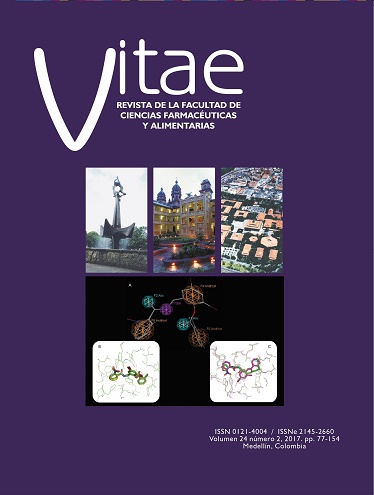Botanical ingredients: the key link in Colombia for the development of innovative and natural pharmaceutical, cosmetic, and food products
DOI:
https://doi.org/10.17533/udea.vitae.v24n2a01Abstract
Botanical ingredients are widely used in food, dietary supplements, cosmetics, drugs, and other products. These ingredients may either be made as fresh material, dry and ground material, or as valorized sub-products obtained following more complex industrial process such as extraction, concentration, and purification. The plant sources of botanical ingredients are diverse. Roots, flowers, fruits, leaves, or seeds could be obtained from i) industrial crops (food and non-food); ii) wild plants (non-agroindustrial development); or iii) agroindustrial wastes (byproducts obtained during harvesting, post-harvesting, and industrial processing). Each of these sources is associated with specific challenges and advantages in the botanical ingredient industry. For example, industrial crops provide the most homogeneous raw material, but the degree of novelty and innovation in the development of these ingredients could be limited. Conversely, wild plants are the best source of novel ingredients; however, they require a lot of time and money to develop. These increased expenditures normally emerge from bioprospecting studies and legal procedures, given that the inclusion of a new ingredient is required. On the other hand, agroindustrial wastes are the most sustainable and environmentally friendly bioingredient sources; however their availability, homogeneity, and innocuousness are the most important challenges to solve.
Downloads
References
Euromonitor International. Botanical ingredients. Retrieved from Euromonitor Passport database. 2017 may.
Chemat F, Vian MA, Cravotto G. Green extraction of natural products: concept and principles. Int J Mol Sci. 2012; 13(7): 8615-8627.
Carrillo-Hormaza L, Ramírez AM, Osorio E, Gil A. Optimization of ultrasound-assisted extraction and rapid resolution analysis of flavanols and methylxanthines for the quality control of cocoa-derived product. Food Anal Method. 2017 Feb; 10(2): 497-507.
Herrero M, Sánchez-Camargo AP, Cifuentes A, Ibañez E. Plants, seaweeds, microalgae and food by-products as natural sources of functional ingredients obtained using pressurized liquid extraction and supercritical fluid extraction. Trends Analyt Chem. 2015 Sep; 71: 26-38.
Azmir J, Zaidul ISM, Rahman MM, Sharif KM, Mohamed A, Sahena F, Jahurul MHA, Ghafoor K, Norulaini NAN, Omar AKM. Techniques for extraction of bioactive compounds from plant materials: A review. J Food Eng. 2013 Aug; 117(4): 426-436.
Adam F, Abert-Vian M, Peltier G, Chemat F. “Solvent-free’’ ultrasound-assisted extraction of lipids from fresh microalgae cells: A green, clean and scalable process. Bioresour Technol. 2012 Jun; 114: 457-465.
Melo MMR, Silvestre AJD, Silva CM. Supercritical fluid extraction of vegetable matrices: Applications, trends and future perspectives of a convincing green technology. J Supercrit Fluids. 2014 Aug; 92. 115-176
Downloads
Published
How to Cite
Issue
Section
License
Copyright Notice and Open Access Statement
The Journal Vitae works under the Open Access license, and the published manuscripts remain available for the public, both on the Journal's website and in databases, under the Creative Commons license, "Noncommercial Attribution" and "Share alike" systems, adopted in Colombia. Hence, when the authors agree to publish in the Journal Vitae, they will not have the right to economic retributions on publications and reproductions through different diffusion media. The documents are freely available to the internet public, permitting users to read, download, copy, distribute, print, search, or link to the full texts and pass them as data to software. The only constraint on reproduction and distribution, should be to give authors control over the integrity of their work and the right to be appropriately acknowledged and cited.
Authors declare that:
-
They are the intellectual property owners and are responsible for all the information stated in the article.
-
This manuscript has not been submitted or published in other printed or digital media. They accept the responsibility for the judgments, opinions, and points of view expressed in the published article and, therefore, they exonerate Universidad de Antioquia and Journal Vitae from any process.
-
They exempt Universidad de Antioquia and Journal Vitae from settling conflicts or disputes related to the authorship of the referred article.
-
They accept the revision of the original manuscript by suitable personnel, and they bind themselves to perform the corrections appointed or suggested by the assessors.
-
Therefore, they know the editorial process and will not bind the Editorial Board of the Journal to assume any obligations regarding the volume and issue in which the article is published.
-
They transfer the rights of publication, reprinting, and distribution of the article from the moment of its approval, in print and digital format, without the right to economic rewards, and under the licensing conditions considered relevant by Journal Vitae.
-
They fully authorize Universidad de Antioquia and Journal Vitae to submit the published material to the diverse databases and indexing systems where the Journal can be found to comply with the requirements of the regulatory authorities to maintain the national classification of journals.
-
They will assume the article publication costs established for the current issue, and they will make the payment as soon as they are informed about the volume and the issue in which the final version of the article is published.
-
After the article is published, you can share digital or printed copies in a noncommercial manner. You will be able to use the paper in your institution or company for educational or research purposes, including the use in course programs.
Conflict of interest: Authors are responsible for recognizing and disclosing any financial or other benefits that could be perceived to bias their work, acknowledging all financial support and any personal connections with potential sponsors. Examples of such conflicts include receiving research funds or honoraria, serving on advisory boards, stock ownership, or employment and consulting arrangements. Authors without such connections should clearly state that they have no financial support or personal relationships that could be perceived to bias their work. All conflicts of interest should be disclosed on the author's identification page of the manuscript.










